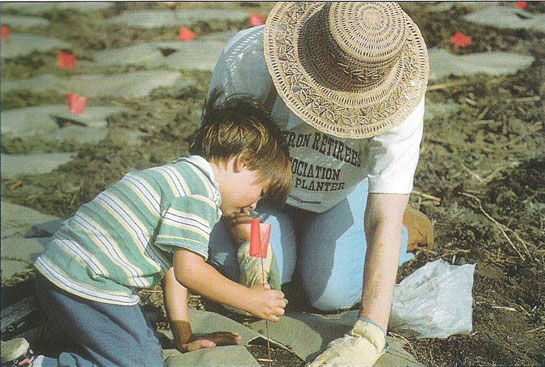All Issues
Nonprofit organizations gaining influence
Publication Information
California Agriculture 54(2):23-24. https://doi.org/10.3733/ca.v054n02p23
Published March 01, 2000
PDF | Citation | Permissions
Full text
Organizations such as The Nature Conservancy have taken on leadership roles in the public debate concerning growth and environmental policy. Volunteers plant seedlings at TNC's Cosumnes River Preserve.
At a recent workshop sponsored by the Bay Area Economic Forum, a distinguished group of Bay Area business executives tackled the question: where will civic leadership for the Bay Area come from in the next millennium? In decades past, major statewide and regional projects such as UC, the State Water Project and Bay Area Rapid Transit (BART) had moved rapidly from concept to fruition largely due to the efforts of a small group of California business executives, usually the heads of large, regionally based corporations.
Today, however, regional business leadership is less civic-minded, often controlled from out-of-state (Bank of America, Southwestern Bell), scrambling to meet new industry challenges (PG&E, Levi-Strauss), or simply too new to establish a role in regional decision-making (Oracle, Yahoo).
For most of those present at the workshop, this was a matter of considerable concern. California's infrastructure is aging and has not expanded in recent years. The concensus view was that prospects were bleak to meet the population, environmental and demographic changes predicted for California in the coming decades.
One presenter, however, offered a surprisingly optimistic countervailing viewpoint. The United States, he noted, is the world leader in nonprofit voluntary associations. These organizations, many of which are now frequently identified by their Internal Revenue Service designation “501(c)(3),” are more prevalent, per capita, in the Bay Area than elsewhere in the United States. This, he suggested, gives the Bay Area an advantage over any other place in the world!
These nonprofit, nongovernmental organizations (NGOs) are restricted in how much legislative advocacy they can do and are strictly prohibited from political activities. But their power and influence have reached unprecedented levels in recent years, affecting issues as diverse as redwood preservation on the north coast of California and the World Trade Organization talks in Seattle. The Worldwatch Institute estimates that up to 70% of the 2 million NGOs in the United States were created during the past 30 years.
Many who make their living in California's agricultural sector have often been at odds with environmental advocates on issues such as water distribution, pesticide use and endangered species. The Sierra Club (now technically a 501(c)(4), which engages in political lobbying and does not receive tax-deductible donations) has been viewed as a problem to agriculture for nearly a century, even though John Muir's early nemeses — such as Michael Maurice O'Shaughnessy, who built the Hetch Hetchy Dam for San Francisco, and Clifford Pinchot, who promoted sustained-yield forestry — were more urban than rural.
Recent additions to California's NGO club, such as Environmental Defense (formerly EDF) and the Natural Resources Defense Council have not been around as long as the Sierra Club but certainly have made their mark. The list of projects affected by these and like-minded organizations, such as The Nature Conservancy, includes dam and power-generation projects stalled, toxic chemicals and pesticides restricted, highways rerouted, developments scaled back, and lands and species preserved. Elsewhere, for example Europe and Japan, NGOs have increased in influence; a notable example is their rallying of consumers against the introduction of genetically modified foods into the marketplace.
Today, nonprofit organizations often float the kinds of broad public-policy ideas and initiatives that were once the exclusive domain of the civic-minded business leaders of the past. Likewise, major foundations such as the San Francisco, Hewlett, Packard and Irvine foundations have taken up environmental causes in recent years, promoting “smart-growth” policies or environmental education and justice through generous grants. In mid-1999, the National Network of Grantmakers which represents 400 foundations that support social change, introduced a campaign called “The Pay-out Initiative: 1% for Democracy,” which encourages foundations to earmark funds for causes such as protecting the environment and fighting poverty.
In the 1970s and early 1980s, litigation was a favorite tool of nonprofit organizations. Freshly minted federal and state legislation such as the National Environmental Policy Act and the California Environmental Quality Act permitted challenges to projects that many California residents saw as unnecessarily destructive to the environment. As federal and state courts became more conservative, however, and government officials and private businesses became more sophisticated in their approaches to project development, litigation has fallen off as the first, or even principal, resort of project opponents.
Instead, other forums have emerged for battles over public policy. Initiatives and referenda, alternative dispute resolution and multistake-holder, collaborative decision-making are among the less conventional means for resolving environmental controversies. Last year, for example, the California Farm Bureau Federation and the Environmental Water Caucus, a coalition representing California nonprofits, engaged in heated head-to-head competition to turn out the most and the best-informed speakers at public hearings on CALFED, the federal-state consortium drafting a new water plan for California.
The alternative visions presented by the Farm Bureau and the EWC at these hearings can be viewed as a metaphor for the major infrastructure and natural-resource dilemmas faced in California. Do we need more dams and canals? How many more highway lanes should be built? Can conservation and efficiency measures do the job instead? Should taxpayers subsidize public-works projects? Can the needs for water, mobility, energy and food be met without additional environmental insult? Indeed, can natural resources devastated by the quest to meet other economic and social objectives now be restored? Can we have it all, prosperity and environmental quality?
No one, of course, knows how these questions will be answered. We do know that in California's future, non-profit organizations will be squarely in the middle of the struggles to address the state's natural-resource, conservation and infrastructure challenges. For better or worse, they may be even more important in the search for answers than the more traditional sectors from which public leadership sprung in the past.





